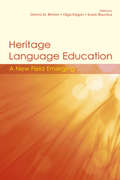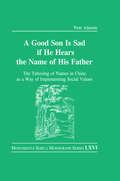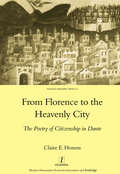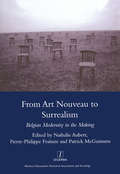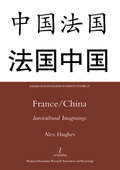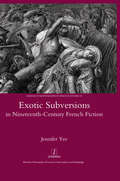- Table View
- List View
Imagining Terrorism: The Rhetoric and Representation of Political Violence in Italy 1969-2009
by Pierpaolo AntonelloNo other European country experienced the disruption of political and everyday life suffered by Italy in the so-called 'years of lead' (1969-c.1983), when there were more than 12,000 incidents of terrorist violence. This experience affected all aspects of Italian cultural life, shaping political, judicial and everyday language as well as artistic representation of every kind. In this innovative and broad-ranging study, experts from the fields of philosophy, history, media, law, cinema, theatre and literary studies trace how the experience and legacies of terrorism have determined the form and content of Italian cultural production and shaped the country's way of thinking about such events?
Imagining Terrorism: The Rhetoric and Representation of Political Violence in Italy 1969-2009
by Pierpaolo AntonelloNo other European country experienced the disruption of political and everyday life suffered by Italy in the so-called 'years of lead' (1969-c.1983), when there were more than 12,000 incidents of terrorist violence. This experience affected all aspects of Italian cultural life, shaping political, judicial and everyday language as well as artistic representation of every kind. In this innovative and broad-ranging study, experts from the fields of philosophy, history, media, law, cinema, theatre and literary studies trace how the experience and legacies of terrorism have determined the form and content of Italian cultural production and shaped the country's way of thinking about such events?
Imagining Jewish Art: Encounters with the Masters in Chagall, Guston, and Kitaj
by Aaron RosenShort-listed for the Art and Christian Enquiry/Mercers' International Book Award 2009: 'a book which makes an outstanding contribution to the dialogue between religious faith and the visual arts'. What does modern Jewish art look like? Where many scholars, critics, and curators have gone searching for the essence of Jewish art in Biblical illustrations and other traditional subjects, Rosen sets out to discover Jewishness in unlikely places. How, he asks, have modern Jewish painters explored their Jewish identity using an artistic past which is- by and large - non-Jewish? In this new book we encounter some of the great works of Western art history through Jewish eyes. We see Matthias Grunewald's Isenheim Altarpiece re-imagined by Marc Chagall (1887-1985), traces of Paolo Uccello and Piero della Francesca in Philip Guston (1913-1980), and images by Diego Velazquez and Paul Cezanne studiously reworked by R.B. Kitaj (1932-2007). This highly comparative study draws on theological, philosophical and literary sources from Franz Rosenzweig to Franz Kafka and Philip Roth. Rosen deepens our understanding not only of Chagall, Guston, and Kitaj but also of how art might serve as a key resource for rethinking such fundamental Jewish concepts as family, tradition, and homeland.
Imagining Jewish Art: Encounters with the Masters in Chagall, Guston, and Kitaj
by Aaron RosenShort-listed for the Art and Christian Enquiry/Mercers' International Book Award 2009: 'a book which makes an outstanding contribution to the dialogue between religious faith and the visual arts'. What does modern Jewish art look like? Where many scholars, critics, and curators have gone searching for the essence of Jewish art in Biblical illustrations and other traditional subjects, Rosen sets out to discover Jewishness in unlikely places. How, he asks, have modern Jewish painters explored their Jewish identity using an artistic past which is- by and large - non-Jewish? In this new book we encounter some of the great works of Western art history through Jewish eyes. We see Matthias Grunewald's Isenheim Altarpiece re-imagined by Marc Chagall (1887-1985), traces of Paolo Uccello and Piero della Francesca in Philip Guston (1913-1980), and images by Diego Velazquez and Paul Cezanne studiously reworked by R.B. Kitaj (1932-2007). This highly comparative study draws on theological, philosophical and literary sources from Franz Rosenzweig to Franz Kafka and Philip Roth. Rosen deepens our understanding not only of Chagall, Guston, and Kitaj but also of how art might serve as a key resource for rethinking such fundamental Jewish concepts as family, tradition, and homeland.
Holocaust Intersections: Genocide and Visual Culture at the New Millennium
by Axel BangertRecent representations of the Holocaust have increasingly required us to think beyond rigid demarcations of nation and history, medium and genre. Holocaust Intersections sets out to investigate the many points of conjunction between these categories in recent images of genocide. The book examines transnational constellations in Holocaust cinema and television in Europe, disclosing instances of border-crossing and boundary-troubling at levels of production, distribution and reception. It highlights intersections between film genres, through intertextuality and pastiche, and the deployment of audiovisual Holocaust memory and testimony. Finally, the volume addresses connections between the Holocaust and other histories of genocide in the visual culture of the new millennium, engaging with the questions of transhistoricity and intercultural perspective. Drawing on a wide variety of different media - from cinema and television to installation art and the internet - and on the most recent scholarship on responses to the Holocaust, the volume aims to update our understanding of how visual culture looks at the Holocaust and genocide today. With the contributions: Robert S. C. Gordon, Axel Bangert, Libby Saxton- Introduction Emiliano Perra- Between National and Cosmopolitan: 21st Century Holocaust Television in Britain, France and Italy Judith Keilbach- Title to be announced Laura Rascaroli- Transits: Thinking at the Junctures of Images in Harun Farocki's Respite and Arnaud des Pallieres's Drancy Avenir Maxim Silverman- Haneke and the Camps Barry Langford- Globalising the Holocaust: Fantasies of Annihilation in Contemporary Media Culture Ferzina Banaji- The Nazi Killin' Business: A Post-Modern Pastiche of the Holocaust Matilda Mroz- Neighbours: Polish-Jewish Relations in Contemporary Polish Visual Culture Berber Hagedoorn- Holocaust Representation in the Multi-Platform TV Documentaries De Oorlog (The War) and 13 in de Oorlog (13 in the War) Annette Hamilton- Cambodian Genocide: Ethics and Aesthetics in the Cinema of Rithy Panh Piotr Cieplak, Emma Wilson- The Afterlife of Images
Holocaust Intersections: Genocide and Visual Culture at the New Millennium
by Axel BangertRecent representations of the Holocaust have increasingly required us to think beyond rigid demarcations of nation and history, medium and genre. Holocaust Intersections sets out to investigate the many points of conjunction between these categories in recent images of genocide. The book examines transnational constellations in Holocaust cinema and television in Europe, disclosing instances of border-crossing and boundary-troubling at levels of production, distribution and reception. It highlights intersections between film genres, through intertextuality and pastiche, and the deployment of audiovisual Holocaust memory and testimony. Finally, the volume addresses connections between the Holocaust and other histories of genocide in the visual culture of the new millennium, engaging with the questions of transhistoricity and intercultural perspective. Drawing on a wide variety of different media - from cinema and television to installation art and the internet - and on the most recent scholarship on responses to the Holocaust, the volume aims to update our understanding of how visual culture looks at the Holocaust and genocide today. With the contributions: Robert S. C. Gordon, Axel Bangert, Libby Saxton- Introduction Emiliano Perra- Between National and Cosmopolitan: 21st Century Holocaust Television in Britain, France and Italy Judith Keilbach- Title to be announced Laura Rascaroli- Transits: Thinking at the Junctures of Images in Harun Farocki's Respite and Arnaud des Pallieres's Drancy Avenir Maxim Silverman- Haneke and the Camps Barry Langford- Globalising the Holocaust: Fantasies of Annihilation in Contemporary Media Culture Ferzina Banaji- The Nazi Killin' Business: A Post-Modern Pastiche of the Holocaust Matilda Mroz- Neighbours: Polish-Jewish Relations in Contemporary Polish Visual Culture Berber Hagedoorn- Holocaust Representation in the Multi-Platform TV Documentaries De Oorlog (The War) and 13 in de Oorlog (13 in the War) Annette Hamilton- Cambodian Genocide: Ethics and Aesthetics in the Cinema of Rithy Panh Piotr Cieplak, Emma Wilson- The Afterlife of Images
Heritage Language Education: A New Field Emerging (Routledge Handbooks In Linguistics Ser.)
by Donna M. Brinton Olga Kagan Susan Bauckus"… focuses on issues at the forefront of heritage language teaching and research. Its state-of-the-art presentation will make this volume a standard reference book for investigators, teachers, and students. It will also generate further research and discussion, thereby advancing the field." María Carreira, California State University – Long Beach, United States "In our multilingual and multicultural society there is an undeniable need to address issues of bilingualism, language maintenance, literacy development, and language policy. The subject of this book is timely…. It has potential to make a truly significant contribution to the field." María Cecilia Colombi, University of California – Davis, United States This volume presents a multidisciplinary perspective on teaching heritage language learners. Contributors from theoretical and applied linguistics, sociolinguistics, psychology, educational policy, and pedagogy specialists explore policy and societal issues, present linguistic case studies, and discuss curricular issues, offering both research and hands-on innovation. - The term "heritage language speaker" refers to an individual exposed to a language spoken at home but who is educated primarily in English. Research and curriculum design in heritage language education is just beginning. Heritage language pedagogy, including research associated with the attrition, maintenance, and growth of heritage language proficiency, is rapidly becoming a field in its own right within foreign language education. This book fills a current gap in both theory and pedagogy in this emerging field. It is a significant contribution to the goals of formulating theory, developing informed classroom practices, and creating enlightened programs for students who bring home-language knowledge into the classroom. Heritage Language Education: A New Field Emerging is dedicated to Professor Russell Campbell (1927-2003), who was instrumental in advocating for the creation of the field of heritage language education.
Heritage Language Education: A New Field Emerging
by Donna M. Brinton Olga Kagan Susan Bauckus"… focuses on issues at the forefront of heritage language teaching and research. Its state-of-the-art presentation will make this volume a standard reference book for investigators, teachers, and students. It will also generate further research and discussion, thereby advancing the field." María Carreira, California State University – Long Beach, United States "In our multilingual and multicultural society there is an undeniable need to address issues of bilingualism, language maintenance, literacy development, and language policy. The subject of this book is timely…. It has potential to make a truly significant contribution to the field." María Cecilia Colombi, University of California – Davis, United States This volume presents a multidisciplinary perspective on teaching heritage language learners. Contributors from theoretical and applied linguistics, sociolinguistics, psychology, educational policy, and pedagogy specialists explore policy and societal issues, present linguistic case studies, and discuss curricular issues, offering both research and hands-on innovation. - The term "heritage language speaker" refers to an individual exposed to a language spoken at home but who is educated primarily in English. Research and curriculum design in heritage language education is just beginning. Heritage language pedagogy, including research associated with the attrition, maintenance, and growth of heritage language proficiency, is rapidly becoming a field in its own right within foreign language education. This book fills a current gap in both theory and pedagogy in this emerging field. It is a significant contribution to the goals of formulating theory, developing informed classroom practices, and creating enlightened programs for students who bring home-language knowledge into the classroom. Heritage Language Education: A New Field Emerging is dedicated to Professor Russell Campbell (1927-2003), who was instrumental in advocating for the creation of the field of heritage language education.
Good Son is Sad If He Hears the Name of His Father: The Tabooing of Names in China as a Way of Implementing Social Values (Monumenta Serica Monograph Ser.)
by Piotr AdamekWhen in 1775 the scholar Wang Xihou compiled a dictionary called Ziguan , he wrote, for illustrative purposes, the personal names of Confucius and the three emperors Kangxi, Yongzheng and Qianlong in the introduction. In oversight, he recorded their complete names. This accidental writing of a few names was condemned by Emperor Qianlong as an unprecedented crime, rebellion and high treason. Wang Xihou was executed, his property confiscated and his books were burnt. His family was arrested and his sons and grandsons were killed or sent as slaves to Heilongjiang. It is surprising what an enormous impact the tabooing of names (bihui ) had on Chinese culture. The names of sovereigns, ancestors, officials, teachers, and even friends were all considered taboo, in other words it was prohibited to pronounce them or to record them in writing. In numerous cases characters identical or similar in writing or pronunciation were often avoided as well. The tabooing of names was observed in the family and on the street, in the office and in the emperor's palace. The practice of bihui had serious consequences for the daily lives of the Chinese and for Chinese historiography. People even avoided certain places and things, and refused to accept offices. They were punished and sometimes even killed in connection with the tabooing of names. The bihui custom existed as an important element of Chinese culture and was perceived as significant by Chinese and foreigners alike. It was crucial for implementing social values and demonstrating the political hierarchy. The present work A Good Son Is Sad if He Hears the Name of His Father is a systematic study of Chinese name-tabooing customs, which until now have been relatively little explored in Western-language Sinological studies. It attempts to provide a long-term perspective on the changing dynamics of tabooing and elucidates various aspects related to the fascinating topic of tabooing of names.
Good Son is Sad If He Hears the Name of His Father: The Tabooing of Names in China as a Way of Implementing Social Values
by Piotr AdamekWhen in 1775 the scholar Wang Xihou compiled a dictionary called Ziguan , he wrote, for illustrative purposes, the personal names of Confucius and the three emperors Kangxi, Yongzheng and Qianlong in the introduction. In oversight, he recorded their complete names. This accidental writing of a few names was condemned by Emperor Qianlong as an unprecedented crime, rebellion and high treason. Wang Xihou was executed, his property confiscated and his books were burnt. His family was arrested and his sons and grandsons were killed or sent as slaves to Heilongjiang. It is surprising what an enormous impact the tabooing of names (bihui ) had on Chinese culture. The names of sovereigns, ancestors, officials, teachers, and even friends were all considered taboo, in other words it was prohibited to pronounce them or to record them in writing. In numerous cases characters identical or similar in writing or pronunciation were often avoided as well. The tabooing of names was observed in the family and on the street, in the office and in the emperor's palace. The practice of bihui had serious consequences for the daily lives of the Chinese and for Chinese historiography. People even avoided certain places and things, and refused to accept offices. They were punished and sometimes even killed in connection with the tabooing of names. The bihui custom existed as an important element of Chinese culture and was perceived as significant by Chinese and foreigners alike. It was crucial for implementing social values and demonstrating the political hierarchy. The present work A Good Son Is Sad if He Hears the Name of His Father is a systematic study of Chinese name-tabooing customs, which until now have been relatively little explored in Western-language Sinological studies. It attempts to provide a long-term perspective on the changing dynamics of tabooing and elucidates various aspects related to the fascinating topic of tabooing of names.
Goethe's Visual World
by Pamela CurrieGoethe's ideas on colour and imagery crossed many borderlines: those of artistic processes and philosophical aesthetics, art history and colour theory, together with the science of perception. This investigation into his writings ranges across art from Antiquity, the Renaissance and the eighteenth century, as well as exploring the centrality of these issues to Goethe's literary work. Questions find answers, but also raise new questions. This systematic sequence of essays, originally written between 1999 and 2011, appeals to readers in all these separate areas, while drawing together their essential coherence.
Goethe's Visual World
by Pamela CurrieGoethe's ideas on colour and imagery crossed many borderlines: those of artistic processes and philosophical aesthetics, art history and colour theory, together with the science of perception. This investigation into his writings ranges across art from Antiquity, the Renaissance and the eighteenth century, as well as exploring the centrality of these issues to Goethe's literary work. Questions find answers, but also raise new questions. This systematic sequence of essays, originally written between 1999 and 2011, appeals to readers in all these separate areas, while drawing together their essential coherence.
Goethe's Poetry and the Philosophy of Nature: Gott Und Welt 1798-1827
by Regina SachersAt the beginning of the nineteenth century, philosophy and theology come under increasing pressure owing to the emergence of the modern sciences. The collection Gott und Welt is Goethe's poetic contribution to this conflict, in which an alternative to orthodox Christianity was being sought. Following the collection's various stages of composition and publication, this study offers new readings of some of Goethe's best known poems: 'Die Metamorphose der Pflanzen', 'Dauer im Wechsel', 'Urworte. Orphisch' and 'Wiederfinden'. Sachers shows that Gott und Welt is the long poem on nature which Goethe attempted to write for the last third of his life. As such it represents Goethe's unique answers to the intellectual challenges posed by the dawning age of science. Regina Sachers is Lecturer in German at Exeter College, Oxford.
Goethe's Poetry and the Philosophy of Nature: Gott Und Welt 1798-1827
by Regina SachersAt the beginning of the nineteenth century, philosophy and theology come under increasing pressure owing to the emergence of the modern sciences. The collection Gott und Welt is Goethe's poetic contribution to this conflict, in which an alternative to orthodox Christianity was being sought. Following the collection's various stages of composition and publication, this study offers new readings of some of Goethe's best known poems: 'Die Metamorphose der Pflanzen', 'Dauer im Wechsel', 'Urworte. Orphisch' and 'Wiederfinden'. Sachers shows that Gott und Welt is the long poem on nature which Goethe attempted to write for the last third of his life. As such it represents Goethe's unique answers to the intellectual challenges posed by the dawning age of science. Regina Sachers is Lecturer in German at Exeter College, Oxford.
German Narratives of Belonging: Writing Generation and Place in the Twenty-First Century
by Linda ShorttSince unification, German culture has experienced a boom in discourses on generation, family and place. Linda Shortt reads this as symptomatic of a wider quest for belonging that mobilises attachment to counter the effects of post-modern deterritorialisation and globalisation. Investigating twenty-first century narratives of belonging by Reinhard Jirgl, Christoph Hein, Angelika Overath, Florian Illies, Juli Zeh, Stephan Wackwitz, Uwe Timm and Peter Schneider, Shortt examines how the desire to belong is repeatedly unsettled by disturbances of lineage and tradition. In this way, she combines an analysis of supermodernity with an enquiry into German memory contests on the National Socialist era, 1968 and 1989 that continue to shape identity in the Berlin Republic. Exploring a spectrum of narratives that range from agitated disavowals of place to romances of belonging, this study illuminates the topography of belonging in contemporary Germany.
German Narratives of Belonging: Writing Generation and Place in the Twenty-First Century
by Linda ShorttSince unification, German culture has experienced a boom in discourses on generation, family and place. Linda Shortt reads this as symptomatic of a wider quest for belonging that mobilises attachment to counter the effects of post-modern deterritorialisation and globalisation. Investigating twenty-first century narratives of belonging by Reinhard Jirgl, Christoph Hein, Angelika Overath, Florian Illies, Juli Zeh, Stephan Wackwitz, Uwe Timm and Peter Schneider, Shortt examines how the desire to belong is repeatedly unsettled by disturbances of lineage and tradition. In this way, she combines an analysis of supermodernity with an enquiry into German memory contests on the National Socialist era, 1968 and 1989 that continue to shape identity in the Berlin Republic. Exploring a spectrum of narratives that range from agitated disavowals of place to romances of belonging, this study illuminates the topography of belonging in contemporary Germany.
From Florence to the Heavenly City: The Poetry of Citizenship in Dante
by ClaireE. HonessDante's political thought has long constituted a major area of interest for Dante studies, yet the poet's political views have traditionally been considered a self-contained area of study and viewed in isolation from the poet's other concerns. Consequently, the symbolic and poetic values which Dante attaches to political structures have been largely ignored or marginalised by Dante criticism. This omission is addressed here by Claire Honess, whose study of Dante's poetry of citizenship focuses on more fundamental issues, such as the relationship between the individual and the community, the question of what it means to be a citizen, and above all the way in which notions of cities and citizenship enter the imagery and structure of the Commedia.
From Florence to the Heavenly City: The Poetry of Citizenship in Dante
by ClaireE. HonessDante's political thought has long constituted a major area of interest for Dante studies, yet the poet's political views have traditionally been considered a self-contained area of study and viewed in isolation from the poet's other concerns. Consequently, the symbolic and poetic values which Dante attaches to political structures have been largely ignored or marginalised by Dante criticism. This omission is addressed here by Claire Honess, whose study of Dante's poetry of citizenship focuses on more fundamental issues, such as the relationship between the individual and the community, the question of what it means to be a citizen, and above all the way in which notions of cities and citizenship enter the imagery and structure of the Commedia.
From Art Nouveau to Surrealism: European Modernity in the Making
by Nathalie AubertThis volume of edited essays is the first one in English to offer a critical overview of the specific features of Belgian modernity from 1880 to 1940 in a multiplicity of disciplines: literature and poetry, politics, music, photography and drama. The first half of the book investigates the roots of twentieth century modernity in Belgian fin de siecle across a variety of genres (novel, poetry and drama), not only within but also beyond the boundaries of Symbolism. The contributors go on to examine the explosion of Belgian culture on the international scene with the rise of the avant-gardes, notably Surrealism: and the contribution made in minor genres, such as the popular novels of Simenon and Jean Ray, and the Tintin comics of Herge.
From Art Nouveau to Surrealism: European Modernity in the Making
by Nathalie AubertThis volume of edited essays is the first one in English to offer a critical overview of the specific features of Belgian modernity from 1880 to 1940 in a multiplicity of disciplines: literature and poetry, politics, music, photography and drama. The first half of the book investigates the roots of twentieth century modernity in Belgian fin de siecle across a variety of genres (novel, poetry and drama), not only within but also beyond the boundaries of Symbolism. The contributors go on to examine the explosion of Belgian culture on the international scene with the rise of the avant-gardes, notably Surrealism: and the contribution made in minor genres, such as the popular novels of Simenon and Jean Ray, and the Tintin comics of Herge.
France/China: Intercultural Imaginings
by Alex HughesChina has long been an object of fascination for the French, who celebrated theirannee de la Chine in 2004. Symptomatic of that fascination are the movements into China made by groups as diverse as the Jesuits, who arrived inL'Empire du Milieu in the late seventeenth century, and theTel Quel intellectuals, whose will to political pilgrimage took th
France/China: Intercultural Imaginings
by Alex HughesChina has long been an object of fascination for the French, who celebrated theirannee de la Chine in 2004. Symptomatic of that fascination are the movements into China made by groups as diverse as the Jesuits, who arrived inL'Empire du Milieu in the late seventeenth century, and theTel Quel intellectuals, whose will to political pilgrimage took th
Fontaine and Cultural Mediation: Translation and Reception in Nineteenth-Century German Literature
by Ritchie Robertson Michael WhiteIn the mid-1880s, the Realist author and Anglophile Theodor Fontane observed:nowhere is so much translation done as in Germany. Characterizing Germany as a special locus of literary translation and reception, Fontane contests a prejudice which has since become a significant problem for nineteenth-century German studies, namely the frequent assessment of the epoch as narrowly national. The present collection of essays by thirteen eminent literary scholars and historians is intended to correct this prejudice: it demonstrates that literary life and production in the nineteenth century were governed by complex networks of intercultural exchange, influence and translation, and it does justice to this complexity through its range of complementary critical approaches, focussing on Fontane, Anglo-German relations, translation, and European reception. In so doing, this book not only offers a nuanced appreciation of literary production and reception in the nineteenth century, but also demonstrates the continued relevance of that period for Germanists today.
Fontaine and Cultural Mediation: Translation and Reception in Nineteenth-Century German Literature
by Robertson RitchieIn the mid-1880s, the Realist author and Anglophile Theodor Fontane observed:nowhere is so much translation done as in Germany. Characterizing Germany as a special locus of literary translation and reception, Fontane contests a prejudice which has since become a significant problem for nineteenth-century German studies, namely the frequent assessment of the epoch as narrowly national. The present collection of essays by thirteen eminent literary scholars and historians is intended to correct this prejudice: it demonstrates that literary life and production in the nineteenth century were governed by complex networks of intercultural exchange, influence and translation, and it does justice to this complexity through its range of complementary critical approaches, focussing on Fontane, Anglo-German relations, translation, and European reception. In so doing, this book not only offers a nuanced appreciation of literary production and reception in the nineteenth century, but also demonstrates the continued relevance of that period for Germanists today.
Exotic Subversions in Nineteenth-century French Fiction
by Jennifer YeeIn the course of the nineteenth century France built up a colonial empire second only to Britain's. The literary tradition in which it dealt with its colonial 'Other' is frequently understood in terms of Edward Said's description of Orientalism as both a Western projection and a 'will to govern' over the Orient. There is, however, a body of works that eludes such a simple categorisation, offering glimpses of colonial resistance, of a critique of imperialist hegemony, or of a blurring of the boundaries between the Self and the Other. Some of the ways in which the imperialist enterprise is subverted in the metropolitan literature of this period are examined in this volume through detailed case studies of key works by Chateaubriand, Hugo, Flaubert and Segalen.



